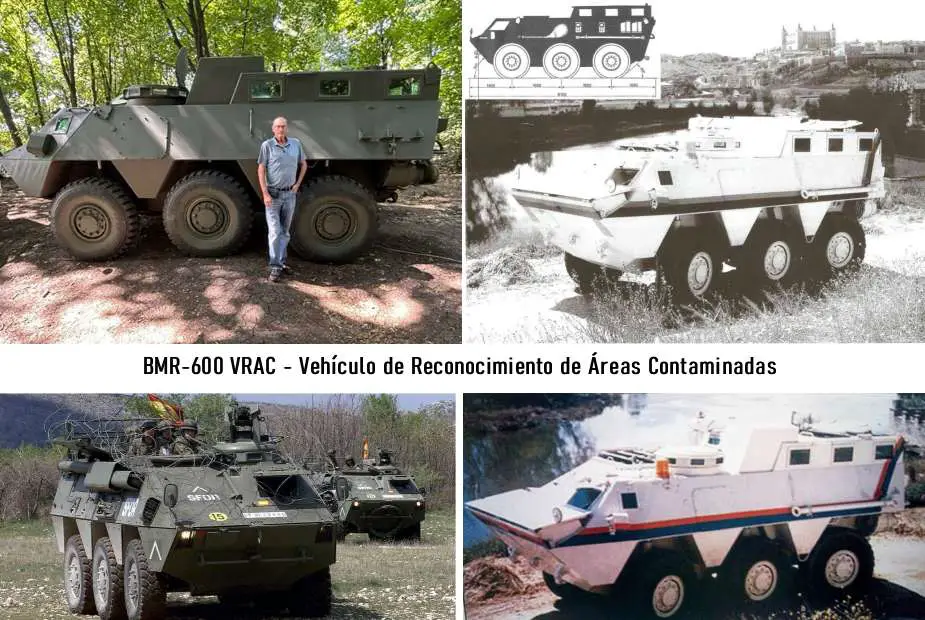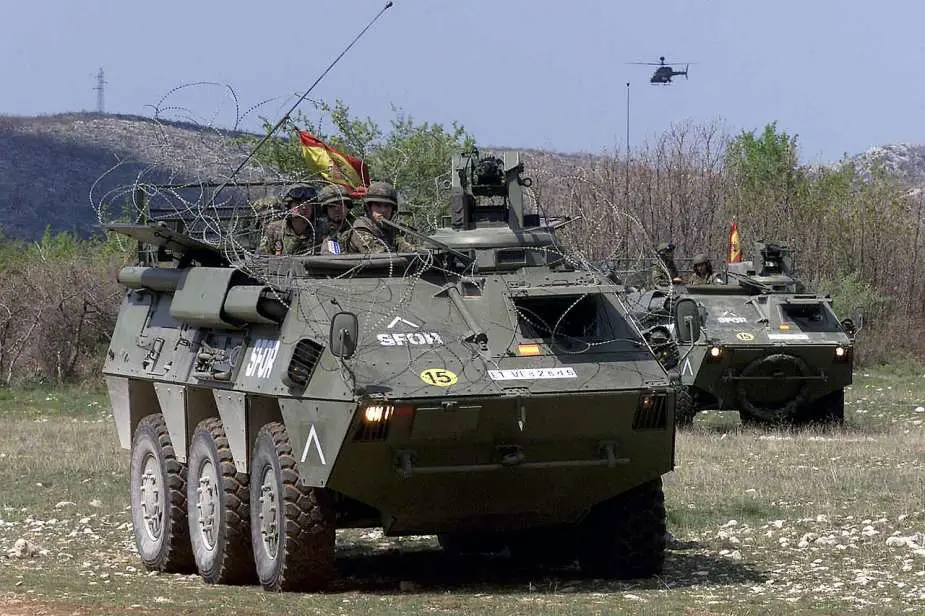According to Autoevolution on September 15, 2023, a Spanish 6x6 BMR-600 VRAC (Contaminated Areas Reconnaissance Vehicle), one of only three known vehicles in existence, has been identified in active service with the Ukrainian Armed Forces. Originally designed for reconnaissance missions in highly contaminated areas, particularly those tainted by nuclear, biological, or chemical (NBC) threats, this exceptionally rare BMR-600 VRAC has undergone a conversion, transforming it into an armored medical evacuation vehicle.
Follow Army Recognition on Google News at this link

One of the three BMR-600 VRAC, an NBC variant of the BMR-600 APC, was spotted in Ukraine (Picture source: Twitter and Wikimedia)
As the conflict in Ukraine continues, the region witnesses a growing diversity of military vehicles, and this BMR-600 VRAC has now emerged as one of the rarest military assets within Ukraine. The VRAC, an abbreviation for Vehículo de Reconocimiento de Áreas Contaminadas (Vehicle for Reconnaissance of Contaminated Areas), represents a specialized adaptation of the Pegaso BMR 3560 APC, a subvariant of the BMR-600 APC first manufactured in 1979 by Empresa Nacional de Autocamiones S.A. (ENASA) for the Spanish Armed Forces.
The BMR 3650 was initially equipped with a Pegaso 9157/8 six-cylinder turbodiesel engine, later upgraded to a more robust 310-horsepower Scania DS9 diesel V6 engine to enhance battlefield reliability. The BMR's reputation for versatility is well-founded, with the capacity for various roles, including that of a tank destroyer, mortar carrier, armored bulldozer, and combat crane. Since their introduction in the early 1980s, Spain has produced approximately 1200 BMR APCs, which have served in conflicts spanning from Yugoslavia and Lebanon to Afghanistan and Iraq.
However, the BMR VRAC is an exceptional rarity, with only three units believed to exist. The circumstances surrounding its presence in Ukraine remain unclear, leaving room for speculation regarding its origin. One theory suggests it may have reached Eastern Europe through surplus auctions following decommissioning by one of the BMR's operators, which include Egypt, Peru, Morocco, Mexico, and Saudi Arabia. Another theory posits a clandestine transfer of military equipment between Spain and Ukraine, potentially evading media attention amidst more prominent arms deals between Ukraine and the United States.

A BMR-600 IFV from the Spanish Army assigned to the Stabilization Force (SFOR) in ex-Yugoslavia in 2002 (Picture source: Wikimedia)
Developed by the Spanish company ENASA in the late 1970s, the BMR-600 6x6 armored personnel carrier was designed to meet the Spanish Army's need for a new infantry combat vehicle. Originally named the Pegaso 3500, it later became known as the BMR-600, which stands for "Blindado Medio de Ruedas" or "medium-wheeled armored vehicle". Not limited to a single role, this vehicle serves as a modular platform that supports various mission profiles. These include versions equipped with mortars, command centers, and artillery support capabilities. Another variant, the Pegaso 3562 VEC (Vehículo de Exploración de Caballería), serves as a cavalry reconnaissance vehicle.
Constructed primarily from aluminum armor, the BMR-600 provides protection against small arms fire and artillery shell splinters, with a weight of 13,750 kg. The vehicle also boasts an NBC (Nuclear, Biological, Chemical) protection system, ensuring the safety of the crew and passengers in hazardous environments.
Regarding capacity, the BMR-600 can accommodate two crew members and transport up to 11 troops, who can enter and exit through the rear ramp doors or roof hatches. Firing ports on each side of the hull allow soldiers to engage targets from within the vehicle.
Powering the BMR-600 is a Pegaso 9157/8 diesel engine, generating 310 horsepower. Its hydropneumatic suspension offers adjustable ground clearance, enhancing off-road performance. The BMR-600 is amphibious, equipped with two hydrojets that enable it to traverse water while maintaining a speed of 10 km/h. On the road, the APC achieves a top speed of 100 km/h and has a maximum range of 600 km.
The BMR-600's primary armament is a remotely controlled 12.7-mm MG, providing effective firepower for a range of combat scenarios. Additionally, different variants can be equipped with various weapon systems, including a 90 mm cannon, a 7.62 mm co-axial machine gun, or 20 mm or 25 mm cannons, offering adaptability to specific operational requirements.
















